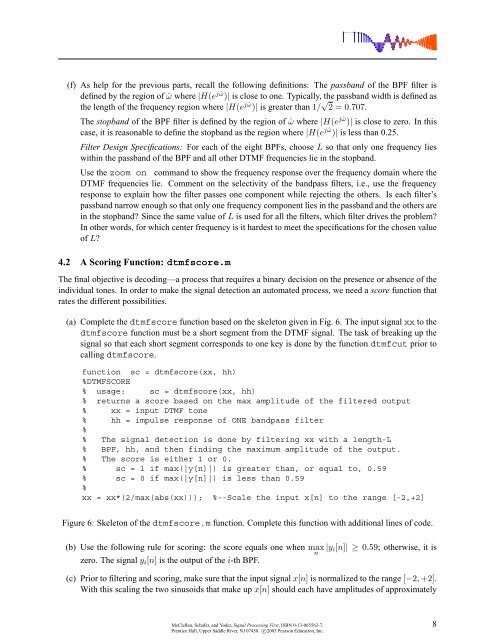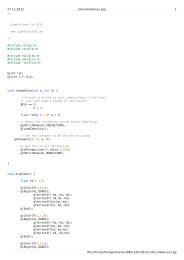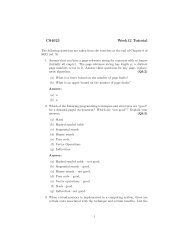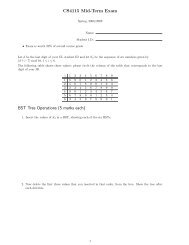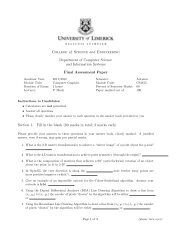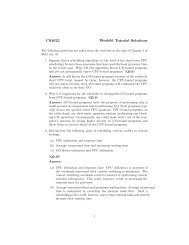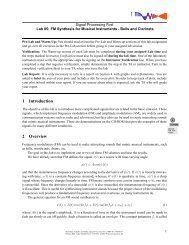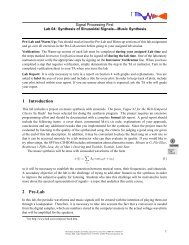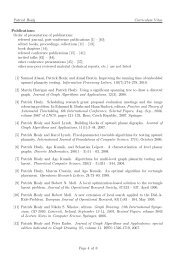Encoding and Decoding Touch-Tone Signals
Encoding and Decoding Touch-Tone Signals
Encoding and Decoding Touch-Tone Signals
You also want an ePaper? Increase the reach of your titles
YUMPU automatically turns print PDFs into web optimized ePapers that Google loves.
(f) As help for the previous parts, recall the following definitions: The passb<strong>and</strong> of the BPF filter isdefined by the region of ˆω where |H(e j ˆω )| is close to one. Typically, the passb<strong>and</strong> width is defined asthe length of the frequency region where |H(e j ˆω )| is greater than 1/ √ 2 = 0.707.The stopb<strong>and</strong> of the BPF filter is defined by the region of ˆω where |H(e j ˆω )| is close to zero. In thiscase, it is reasonable to define the stopb<strong>and</strong> as the region where |H(e j ˆω )| is less than 0.25.Filter Design Specifications: For each of the eight BPFs, choose L so that only one frequency lieswithin the passb<strong>and</strong> of the BPF <strong>and</strong> all other DTMF frequencies lie in the stopb<strong>and</strong>.Use the zoom on comm<strong>and</strong> to show the frequency response over the frequency domain where theDTMF frequencies lie. Comment on the selectivity of the b<strong>and</strong>pass filters, i.e., use the frequencyresponse to explain how the filter passes one component while rejecting the others. Is each filter’spassb<strong>and</strong> narrow enough so that only one frequency component lies in the passb<strong>and</strong> <strong>and</strong> the others arein the stopb<strong>and</strong>? Since the same value of L is used for all the filters, which filter drives the problem?In other words, for which center frequency is it hardest to meet the specifications for the chosen valueof L?4.2 A Scoring Function: dtmfscore.mThe final objective is decoding—a process that requires a binary decision on the presence or absence of theindividual tones. In order to make the signal detection an automated process, we need a score function thatrates the different possibilities.(a) Complete the dtmfscore function based on the skeleton given in Fig. 6. The input signal xx to thedtmfscore function must be a short segment from the DTMF signal. The task of breaking up thesignal so that each short segment corresponds to one key is done by the function dtmfcut prior tocalling dtmfscore.function sc = dtmfscore(xx, hh)%DTMFSCORE% usage: sc = dtmfscore(xx, hh)% returns a score based on the max amplitude of the filtered output% xx = input DTMF tone% hh = impulse response of ONE b<strong>and</strong>pass filter%% The signal detection is done by filtering xx with a length-L% BPF, hh, <strong>and</strong> then finding the maximum amplitude of the output.% The score is either 1 or 0.% sc = 1 if max(|y[n]|) is greater than, or equal to, 0.59% sc = 0 if max(|y[n]|) is less than 0.59%xx = xx*(2/max(abs(xx))); %--Scale the input x[n] to the range [-2,+2]Figure 6: Skeleton of the dtmfscore.m function. Complete this function with additional lines of code.(b) Use the following rule for scoring: the score equals one when max |y i[n]| ≥ 0.59; otherwise, it iszero. The signal y i [n] is the output of the i-th BPF.(c) Prior to filtering <strong>and</strong> scoring, make sure that the input signal x[n] is normalized to the range [−2, +2].With this scaling the two sinusoids that make up x[n] should each have amplitudes of approximatelynMcClellan, Schafer, <strong>and</strong> Yoder, Signal Processing First, ISBN 0-13-065562-7.Prentice Hall, Upper Saddle River, NJ 07458. c○2003 Pearson Education, Inc.8


